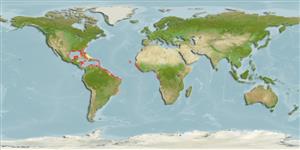Environment: milieu / climate zone / depth range / distribution range
Écologie
marin démersal; profondeur 21 - 70 m (Ref. 2683), usually ? - 50 m (Ref. 26999). Subtropical; - 25°S
Western Atlantic: Bermuda and southern Florida, USA to Brazil. Lesser Antilles (Ref. 26938). Eastern Atlantic: Senegal to Angola (Ref. 4455). Doubtful record from the western Mediterranean (Ref. 13729).
Taille / Poids / Âge
Maturity: Lm ? range ? - ? cm
Max length : 210 cm TL mâle / non sexé; (Ref. 26938); common length : 100.0 cm TL mâle / non sexé; (Ref. 5217)
Body pale, dark band across back of head (Ref. 26938).
Maximum depth from Ref. 126840. Lives in a permanent burrow, often in very shallow water. Heads protrude diagonally from the sand. Nocturnal. Feeds on octopus and fish (Ref. 5217). Bold and easily approached. Feared by fishers (Ref. 9710). Rarely consumed (Ref. 3795).
Life cycle and mating behavior
Maturities | Reproduction | Spawnings | Egg(s) | Fecundities | Larves
Böhlke, J.E., 1981. Ophichthidae. In W. Fischer, G. Bianchi and W.B. Scott (eds.) FAO species identification sheets for fishery purposes. Eastern Central Atlantic, (Fishing Areas 34, 47 (in part)), Vol. 3, [var. pag.]. FAO, Rome. (Ref. 3651)
Statut dans la liste rouge de l'IUCN (Ref. 130435)
Menace pour l'homme
Reports of ciguatera poisoning (Ref. 30911)
Utilisations par l'homme
Pêcheries: sans intérêt; appât: usually
Outils
Articles particuliers
Télécharger en XML
Sources Internet
Estimates based on models
Preferred temperature (Ref.
123201): 19.2 - 27.5, mean 24.8 °C (based on 156 cells).
Phylogenetic diversity index (Ref.
82804): PD
50 = 0.5000 [Uniqueness, from 0.5 = low to 2.0 = high].
Bayesian length-weight: a=0.00089 (0.00039 - 0.00204), b=3.00 (2.80 - 3.20), in cm total length, based on LWR estimates for this (Sub)family-body shape (Ref.
93245).
Niveau trophique (Ref.
69278): 4.5 ±0.80 se; based on food items.
Résilience (Ref.
120179): Très faible, temps minimum de doublement de population supérieur à 14 ans (Preliminary K or Fecundity.).
Fishing Vulnerability (Ref.
59153): Very high vulnerability (90 of 100).
